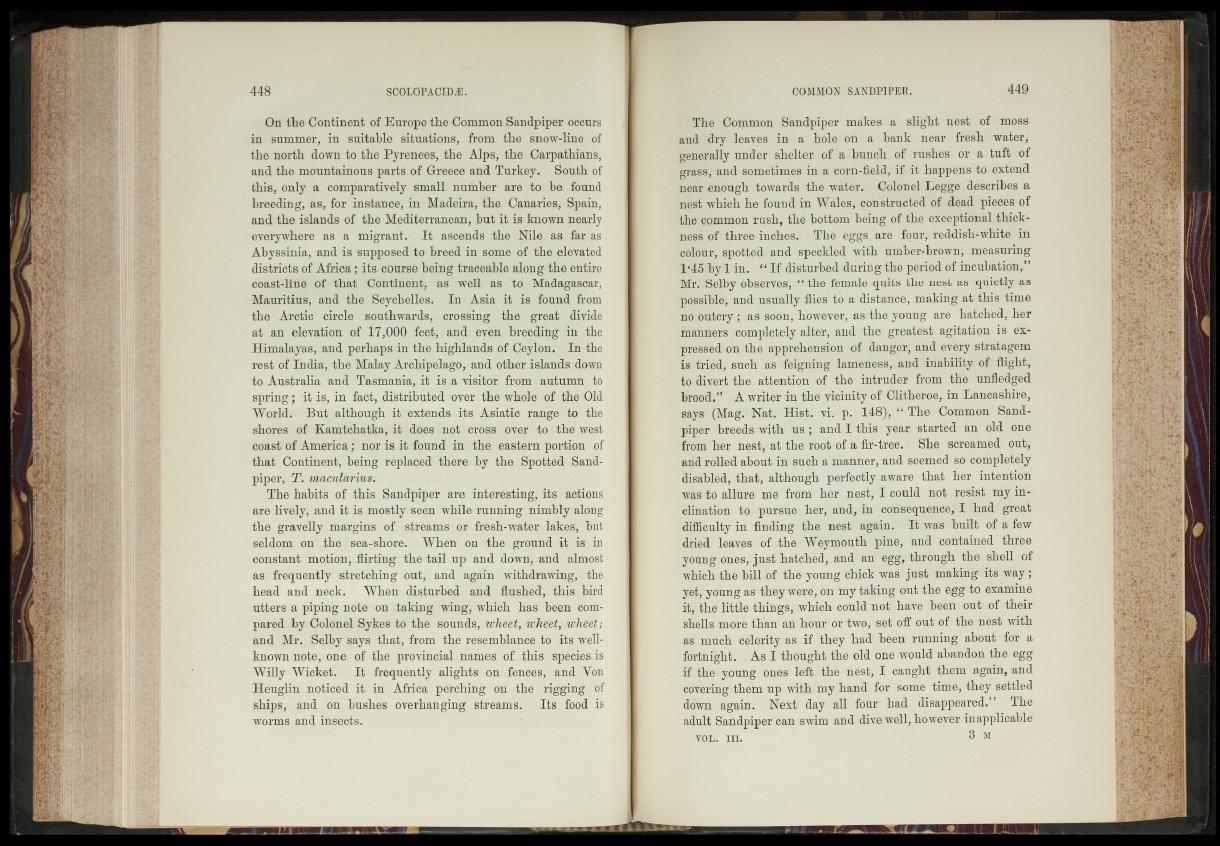
On the Continent of Europe the Common Sandpiper occurs
in summer, in suitable situations, from the snow-line, of
the north down to the Pyrenees, the Alps, the Carpathians,
and the mountainous parts of Greece and Turkey. South of
this, only a comparatively small number are to he found
breeding, as, for instance, in Madeira, the Canaries, Spain,
and the islands of the Mediterranean, but it is known nearly
everywhere as a migrant. It ascends the Nile as far as
Abyssinia, and is supposed to breed in some of the elevated
districts of Africa; its course being traceable along the entire
coast-line of that Continent, as well as to Madagascar,
Mauritius, and the Seychelles. In Asia it is found from
the Arctic circle southwards, crossing f the great divide
at an elevation of 17,000 feet, and even breeding^m; .the
Himalayas, and perhaps in the highlands of :Ceylon. Im the
rest of India, the Malay Archipelago, and other islands down
to Australia and Tasmania, it is a visitor' from autumn to
spring; it is, in fact, distributed'rover, the whole of the Old
World. But although it extends dts Asiatic range to the
shores of Kamtchatka, it does "not -cross oyer to the^svest
coast of America; nor is it found in -the eastern portion of
that Continent, being replaced there by the Spotted Sandpiper,
T. macvM/rius.
The habits of this Sandpiper are interesting, its actions
are lisfely, and it. is mostly seen while running nimbly along
the gravelly margins b£ l - stream s j or ■ fresh-water- lakesf^hnt
seldom on the Jsea-sshore.\ When on' -the > ground it is jin
constant motion, flirting the tail up and down; and'f-almost
as frequently stretching out, and again withdrawing/.1 the
head and neck. When disturbed and f flushed, thislbird
utters a piping note on ^taking wing, which has been compared
by .Colonel Sykes to the sounds, wheel} wheep, 'wheel ;
and Mr. Selby says that,virpm the Resemblance wellknown
note, one. of the provincial names -of this species is
Willy Wicket. It frequently alights on fences, and Von
Heuglin noticed it^in Africa perching oif the rigging of
ships, and on bushes overhanging streams. Its food 0 '
worms and insects.
' The'; Common Sandpiper- makes a slight nest *of moss
and dry leaves in a hóle oh a bank I near feisitJ water,
generally under shelter of a bunch, of rushes, or a tuftuof
grass, and sometimes in a corn-field, if it happens: to extend
near enough towards the water/' Colonel Legge describes a
nest which he found in Wales, constructed of dead pieces of
the common rush, the bottdm being of the exceptional thickness
dft three; inches. APhe-. eggs are four, rèddîtâf-'tâdte in
colour, spotted and -speckled- with utoberdbrown, measuring
I'dAby 1 in. “ If'.disturbed- duriug;theperiod,of incubation,”
Mr. Selby o b s e r v e s ,f em a l e quits the nest as quietly as
possible, and usually flies'to a .distance, making at this time
no outcry ; as-.soon,'however, as.the^young are hatched, her
manners completely : alter,- ^and Éfejj greatest?; agitation is expressed
on 'the apprehension: of danger, and every stratagem
is tried,I suck as feigning lameness,, and. inability of flight;
to divert the- attention of the intruder from the unfledged
brood.” - A writer''in’4ke-vicinity of Clitheroe,’m Lancashire,
says (Mag. Nat. Hist. vi. p. Æ4ê)y “ The Common Sand-
pipèr ‘breeds with us ; ànd I this5 year started; an old .one
from her nest,-at the root of a fir-tree. She screamed out,
and rolled about in such-a manner, and seemed so completely
disabled, that, although perfectly .aware that'her intention
was to allure me from her negt/ûBsCould not- resist- my inclination
to,.pursue--her, and, in consequence/1 had great
difficulty in finding the- nest; again. It was'-built of à'few
-dScd leaves -M the - Weymouth jSb», and p#ntainedi three
young ones,-justhatched,‘and an égg; through the shell of
wHieh the hill of the young chick was ' just making its way ;
yet,-young as-'they were, on my taking okt -the egg'to examine
ft/’the little things, which? could not - have ’been I out- ©ft their
shells-mere than aü hour'or tWO'/ set off out of the nest with
as much celerity&s if they had been running about for a
fortnight. As I thoüght'®he old one would abandon the egg
if the young ones left î-t'he nest, I . Caught them again, and
covering them up with my hand for some time, they-settled
down again. Next day all four had disappeared/’ The
adult Sandpiper-can swim and dive well, however inapplicable.
VOL. in . ^ M